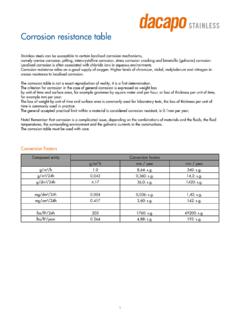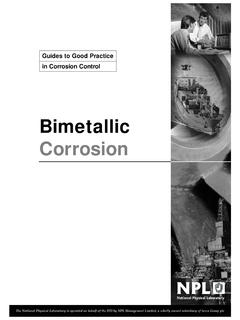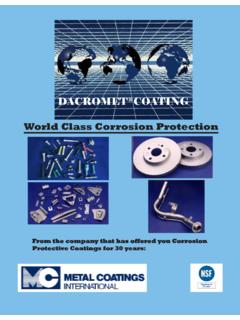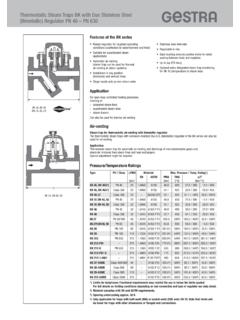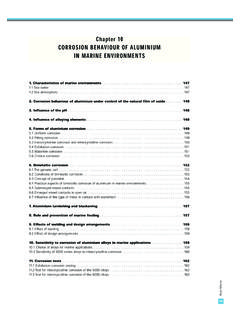Transcription of Galvanic Table - Design by Initiative
1 Galvanic Table 304 SS to MS Diff Volts whereas in a passive state Volts 316 SS to MS Diff Volts whereas in a passive state Volts (shaded) Point of reference Voltage differential between Mild (MS) and Stainless steel (SS) is known to be unsuitable in saliferous environments without isolation measures. The unshaded symbols show ranges exhibited by stainless steels in acidic water such as may exist in crevices or in stagnant or low velocity or poorly aerated water where Stainless Steel become active, while the shaded areas show the potentials of Stainless Steel when is in passive state. Galvanic Table Notes The Galvanic Series of Metals can be used to determine the likelihood of a Galvanic reaction, and Galvanic corrosion or bimetallic corrosion , between two different metals in a seawater environment.
2 The seawater Galvanic series is used also to approximate the probable Galvanic effects in other environments for which there are no data. The Galvanic corrosion Chart says that the "anodic" or "less noble" metals at the negative end of the series - at the right of this diagram, such as magnesium, zinc and aluminium - are more likely to be attacked than those at the "cathodic" or "noble" end of the series such as gold and graphite. The most noble metal lower in the Galvanic Series, will be the cathode while the less noble, higher in the Galvanic Series, will act as an anode and it will corrode. Permissible couples to avoid Galvanic corrosion of aluminium when placed in contact with more noble materials are limited to a potential difference of V on the Galvanic series. A difference of hundreds of millivolts is likely to result in Galvanic corrosion , but only a few tens of millivolts is unlikely to be a problem Anodic current density and hence corrosion rates can be reduced by increasing the anode-to-cathode surface area ratio; if a small area of stainless steel is placed in contact with a big area of aluminum the rate of aluminum Galvanic corrosion is low due to the effect of the relative areas.
3 The critical point is the difference in potential of the two materials being considered as a joined pair.
